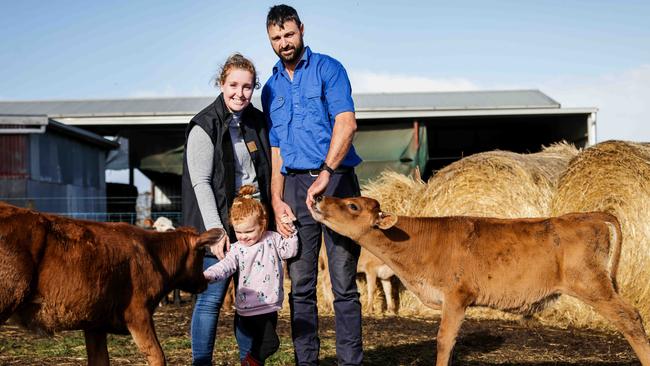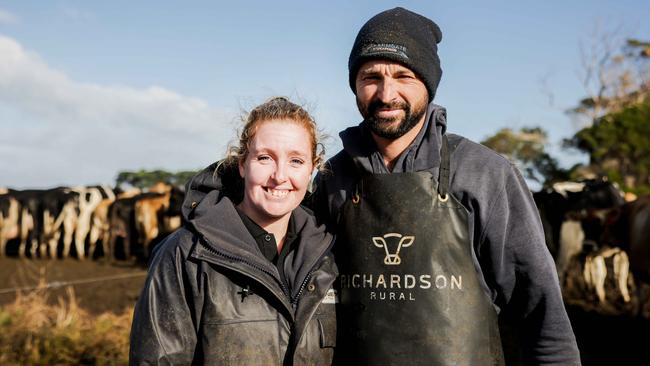Chloe and Rodney Brown: Kirkstall dairy family
A Western District dairying couple are focused on nailing the basics as they look to expand production on their Kirkstall family farm.

With a focus not on expansion, but on getting the basics right, growing quality grass, and increasing milk production, the Brown family have their sights set on humble yet profitable goals.
Chloe Brown and her husband Rodney, along with their two young daughters Charlotte and Ella, run 220 Jersey cows at their family farm at Kirkstall in the Western District.
Farming across 134ha, which they lease from Rodney’s parents, the Browns are working towards slowly buying the property in their own right, while boosting milk production per cow and growing lush fodder for their cattle.
It’s a goal Chloe said they had been working on since returning to the farm in 2016, following the milk price crash.
“We were in a sharefarming agreement prior to that, and when the milk price dropped, we couldn’t afford to sustain both,” Chloe said.
“So we sold most of our cows, and took five months out.”
Rodney was still involved in the farm, helping to feed cows and doing some of the labour.

But the couple were keen to get back into the farm.
They eventually made their way back in 2016, and started supplying Fonterra in November 2016.
“The option came to us where we could get back onto the family farm,” Chloe said. “We came back on and took on the whole lease, with a five-year plan to look at purchasing, or to try and build more equity to buy moving forward.”
“Coming back in was tough … we had parked some of our cows, but (Rodney’s parents) still had some of their cows.
“We were then able to lease-purchase the cows.
“We now officially own the entire herd.
“That was a really great way to get our foot in the door, without having to buy out the entire herd.”
JERSEY LOVERS
Jerseys are the favoured breed for the Browns, accounting for about 75 per cent of their herd, with some Friesian cattle scattered throughout as well.
Chloe said the breed was better suited for their property and milking enterprise.
“We were probably about 50/50 Jersey to Friesian. (The Jerseys) aren’t as harsh on the paddocks, their milk conversion is much better, so we can grow more grass to convert to milk,” Chloe said.
“They make us more solids, so we get paid better.
“And Rodney has always liked the Jerseys.”
Milk solids per cow are sitting at about 530kg of milk solids, or between 6-6.5 litres per cow.
Those figures have lifted from 2018, when the Browns’ cows were producing about 450kg milk solids per cow. Cows produce about 20 litres per cow per day currently.
Rodney said cell count has been a focus in the past year.
“We use a teat seal and blanket dry cow treatment at dry off. Last year we would sit between 150-250 bulk milk cell count, this year we are averaging 50-80 BMCC. The aim is to keep it under 100.”
OUTPUT COUNTS
They have also had a focus on feed, Chloe said.
“We’ve had three really good seasons, with good grass and paddocks, we graze them properly, and the cows convert really well,” Chloe said.
The Brown’s farm consists of black flats of clay soil, with perennial pastures.
“And it’s dead flat. It’s not got a hill on it,” Chloe said.
Cows are fed about 5.6 tonnes of dry matter per year — about 1.8 tonnes grazed grass, 1.8 tonnes purchased grain, and another 2 tonnes of homegrown fodder. Annual rainfall is between 750-900mm, But it’s been a dry start to the year, Chloe said, which has the potential to put pressure on their feed system.

“We are really, really dry.”
“We had really good January rain, after a super dry December.
“But we literally had 25mm in February, 40mm in March, and 20mm in April.
“We’re quite a bit down from where we would normally sit. The autumn break has been a bit slower.”
Despite the lack of rain, the unrenovated perennial pastures across the property are holding on well.
Summer crops are planted each year, last year it was turnips, and a feed wedge comprising about three pastures was designed to boost fodder supplies throughout the year.
“Because we know we are going to get drier, and we are not irrigated, we are completely dryland and dependent on the radar,” Chloe said.
CALVING BONUS
Cows calve in March each year, which fits into the Browns’ feed program.
“The cows do better, and the calves are up and healthy before the wet weather kicks in. But it does mean that we don’t have them going on to green feed to start with,” Chloe said.
“It’s just one calving a year, and that’s been a conversion as well. About four years ago we moved to bring calving together.”
Calving once a year allows the Browns to take advantage of the increase of milk price during April, May and June.
“The factory pay us better for milk in those months so we might as well have as much milk in the vat as possible,” Rodney said.
“It’s also much easier from a management perspective. Knowing what stage of lactation all of the cows are at means we can easily make decisions for the whole herd rather than compromising one group.”
Synchronising feed growth patterns with calving is one example of the Browns’ focus on using the land they have to better leverage milk production.
“We are looking at getting some pastures ready that cows can go onto, some green feed around February,” Chloe said.
“We’d eat the summer crop off into February.”
Silage has been reserved from previous years, along with some purchased vetch, which has eased any concerns for conserved feed heading into winter. Rotational grazing is another key element to the Browns’ enterprise.
“We’ve got a keen focus on the cows going around the farm, instead of night and day paddocks,” Chloe said.
At the start of the season, cows are moved from the front half of the farm, all the way down the length of the rectangle-shaped property, and back up once more. Cows are rotated around the farm, depending on available grass, and will get around one to four feeds between milkings.
This allows the Browns to graze more grass in the winter.
“The issue is we can come unstuck at the end of the season, when we’re not sure if we’ll have enough grass.
“But the benefit is, if the cows are still milking quite well, then you’ll have enough profit to be able to buy in (feed) if we need it,” Chloe said.
“We haven’t had that issue yet, but we may have it this year if the forecast doesn’t play out.”
A feed pad installed about eight years ago has helped with both feeding cattle, and also protecting paddocks from tractor damage when the weather is too wet.
LESS IS MORE
Being entirely landlocked, the Browns have no desire to expand the footprint of their property, and no plans to boost their herd by much more.
“We might even be overstocked at 220 (cows),” Chloe said.
“In the good years, we’ve been able to maintain that. But we can still make good money on 200 cows.”
It’s about playing to their strengths, and not overstretching their resources and abilities, Chloe said.
No other employees are on farm, so anything that is undertaken must be done by the couple themselves.
“So we’re not overstretching ourselves.”
Chloe said one task for the future is the removal of Cyprus trees from the property, with the aim to revegetate.
But as they stare down the barrel of a potentially dry winter, the Browns will focus on nailing the basics, ensuring the cattle they do have make the most of the grass and fodder available to them.
“We’ve been focusing on the basics of the property … they’re not flashy or fancy, and it doesn’t mean you get to buy a new tractor every year,” Chloe said.
“We supply Fonterra, always have. Milk price is great at the moment and has been the last few years — even with the increase of farm inputs there is absolutely money to be made in this current season and the next.
“The 10c step-up we have just received is a great way to end the season.
“But if you cover the basics, get them really right, if you’re growing grass and converting it to milk, making sure your young stock are strong … then the profit comes. And the milk comes.
“And you end up doing a balanced business very well.”





